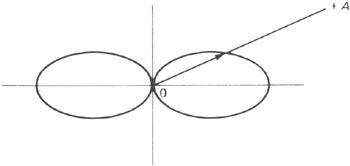Schaum's Outline of Theory and Problems of Electronic Communication, Second Edition

An antenna is a device whose function is to radiate electromagnetic energy and/or intercept electromagnetic radiation. A transmitting antenna can be used for reception and vice versa. In two-way communications, the same antenna is used for both transmission and reception.
Antennas do not necessarily perform equally well in all directions. A polar diagram which indicates how well an antenna transmits or receives in different directions is called a radiation pattern.
Figure 6-1 is a radiation pattern for an antenna known as a Marconi antenna.

Figure 6-2 is a radiation pattern for an antenna known as a Hertz antenna. The distance from the location of the antenna to a point on the radiation pattern indicates the relative strength of the radiation in the direction determined by these two points.

Once a radiation-pattern diagram exists, as in Fig. 6-3, to determine the relative strength of the signal at point A, a line is drawn from the origin, point O, to point A. The intercept of this line with the radiation pattern determines the termination of the vector. When an antenna is being used for receiving purposes, the radiation pattern becomes a reception pattern. The long section of the lobes of the pattern indicates the best direction for reception.

It is frequently necessary to have a quick means of comparing the directivity of antennas without going through a point-by-point comparison of their radiation...
